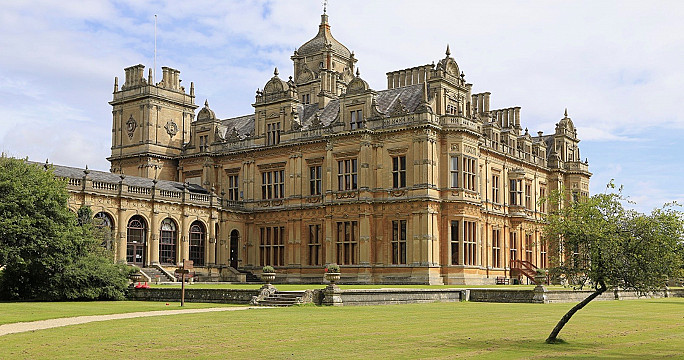Westonbirt House
Tetbury, Gloucestershire
Completed in 1870, for Robert Stayner Holford (1808-1892) and his wife May Lindsay (1829-1901). The Westonbirt estate had been held by the Holford family since 1666. The original Elizabethan manor house was replaced with a Georgian mansion in 1823 that was demolished just forty years later (1863) to allow work to start on the present Westonbirt House, designed by Lewis Vulliamy in the Elizabethan style. The Holfords lived between here and Dorchester House in London, as did their son, Sir George Holford, who was one of King Edward VII's closest friends. After George died, his nephew sold the estate and since then its been home to Westonbirt School & Aboretum....

This house is best associated with...
Robert Holford's grandfather added to his already substantial coffers by supplying London with fresh water through a canal that made him an "immense fortune". In 1838, Robert inherited over a million pounds from his uncle that he explained had been accumulated through "hereditary thrift, along with a cache of bullion" buried on his uncle's estate on the Isle of Wight in fear of an invasion from Napoleon's army. Robert's father died the following year when Westonbirt became his too. He was now able to indulge his passion for art and literature and he began to amass what would become known as the "Holford Collection" before hiring the architect Lewis Vulliamy to build Dorchester House on London's Park Lane where he could display and share his magnificent collection.
In 1863, Robert rehired Vulliamy this time to rebuild Westonbirt - and it was reputed to be one of the most expensive houses constructed in Victorian times. In line with American modernity, it was fitted with the latest technologies such as gas lighting, central heating, fireproof materials, and iron roofs. Robert began the famous Westonbirt Arboretum in 1829 and his son (who preferred horticulture over art and literature) continued to oversee its expansion. In 1875, a French diplomat visiting Westonbirt commented, "Mrs Holford... took me about the house, which surpasses in magnificence any that you know. There is a hall, a sort of conservatory three stories high, something like the great apartments of Louis XIV. The most original room in the house is the one painted by Mrs Holford, in a bizarre fanciful style, something between Delacroix landscape and Rouen pottery".
Sir George died in 1926 and having no children of his own he left Westonbirt, Dorchester House, and his fortune to his nephew, the 4th Earl of Morley, who promptly sold both houses and the Holford Collection. The Dutch and Flemish pictures were auctioned off by Christies in 1928 to a crowd of 10,000-people. The pictures fetched £364,094 which broke the world record for a two-day auction. The Italian paintings were sold in the previous year as was the Holford Library, fetching £16,015. Even Sir George's famous collection of orchids were sold, but the family chose to gift the Arboretum to the nation in 1956.
Sir George died in 1926 and having no children of his own he left Westonbirt, Dorchester House, and his fortune to his nephew, the 4th Earl of Morley, who promptly sold both houses and the Holford Collection. The Dutch and Flemish pictures were auctioned off by Christies in 1928 to a crowd of 10,000-people. The pictures fetched £364,094 which broke the world record for a two-day auction. The Italian paintings were sold in the previous year as was the Holford Library, fetching £16,015. Even Sir George's famous collection of orchids were sold, but the family chose to gift the Arboretum to the nation in 1956.
You May Also Like...
Categories
Styles
Share
Connections
Be the first to connect to this house. Connect to record your link to this house. or just to show you love it! Connect to Westonbirt House →














